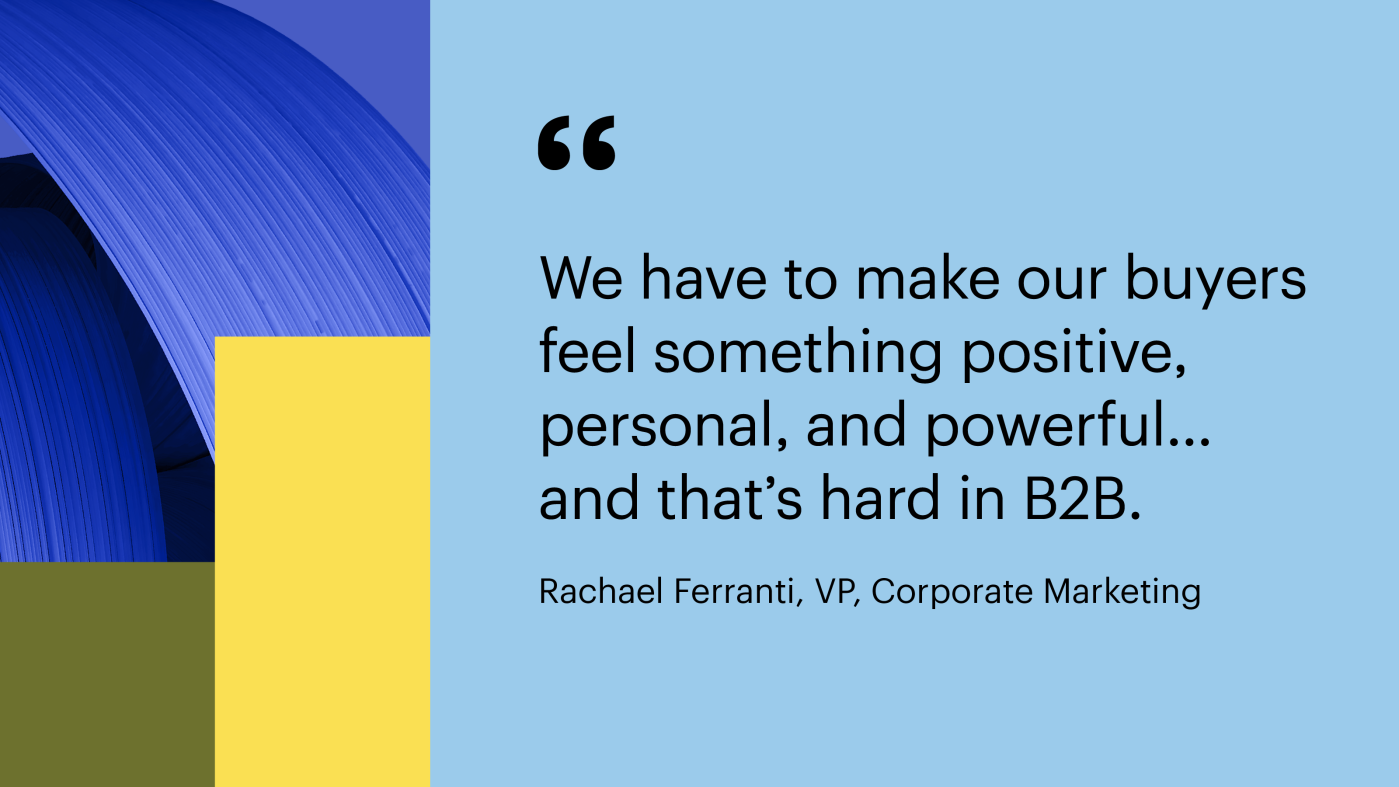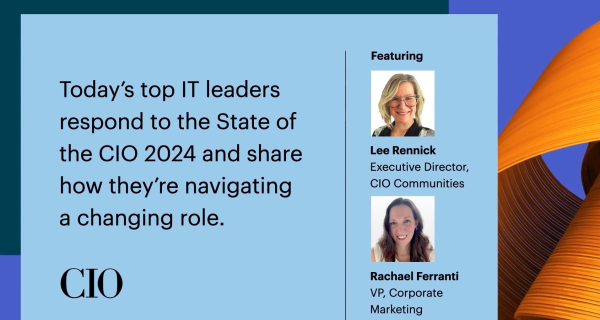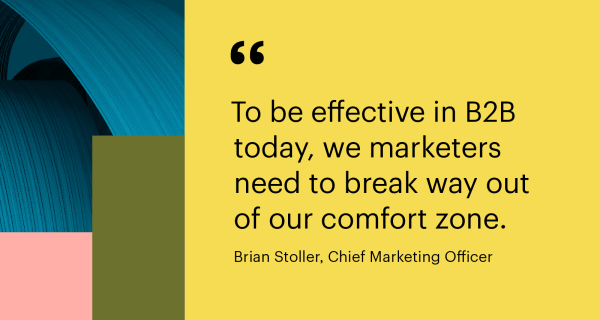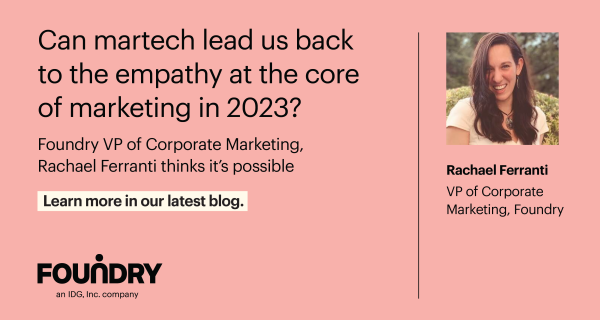With an average of 25 stakeholders to impress, months-long buying journeys, and competing for mindshare on noisy channels, B2B marketers need to leverage the power of story now more than ever.
I’ll preach to anyone who will listen—marketing is hard work as it is, but B2B marketing is even harder.
On its face, the textbook definition of marketing (B2B or otherwise) as “the act of creating and communicating the value of an offering to customers in order to promote the buying of said offering” may seem simple and straightforward. But as anyone in this line of work can attest to, creating good, effective marketing—the kind that has not only been served to the right people at the right time, but that has actually stuck with them and made them care—is like conjuring magic.
We’ve all experienced it, and we all strive to produce it ourselves—a campaign, a tag, an image that gives you pause for any number of reasons. Maybe the ad has made you laugh, maybe it’s made you cry. Maybe the headline gave you goosebumps, maybe the design was so striking it stopped your scroll.
Whatever the response, magical marketing is when we allow that ad or that tagline to burrow in and make residence of our brains even though we’ve denied entry to so many others. It’s connected with us on some personal, emotional level.
And yes, there’s a lot more going on behind the scenes than just the creative and messaging. Today’s marketing requires us to be tight when it comes to our data, and channels, and mediums, and software, and value propositions, and customer alignment—the things that allow us to know who we’re reaching and to actually get our message out. But in my experience, we spend far less time orchestrating, automating, and distributing our message than we do ideating, writing, and designing it. After all, while our data and martech and target lists are the gas that makes the car go, our messaging is what makes our customers want to come along for the ride.
In short, we have to make our audience feel something if we want our marketing to have any real impact, and that something—whether it be amused, moved, inspired, or validated—has to be positive, personal, and powerful.
And that’s hard to do in B2B.
Mission improbable
Yes, us B2B marketers are a special bunch of folks with the almost impossible task of taking entirely utilitarian products—software, hardware, services—and eliciting a strong positive emotional response when someone thinks about it. Actually, more like 25 someones—all at once and also on an individual basis. All while battling against the reality that the products we’re selling at face value aren’t all that warm and fuzzy.
Let’s contrast this to B2C marketing. While I would never commit the faux pas of labeling B2C marketing as easy, B2C marketers do generally have a leg up on B2B marketers in the visceral appeal department. As both an experienced B2B marketer who knows the tricks of the trade and an avid personal consumer (shopaholic?), B2C marketing efforts genuinely catch my attention and win me over 100:1 versus B2B. And as any good marketer would do, I’ve taken the time to examine my own reaction to B2C ads and this is the conclusion I’ve come to:
What these consumer brands get right is what we try but often fail to do in B2B marketing and selling—they promise a lifestyle improvement, they make it easy for me to see myself in and around their products, and they get what pulls on my heartstrings. They successfully walk me through multiple stages of the buyer journey (need identification, research, evaluation, and decision) simultaneously with something more powerful pulling me along—story.
It’s the nice new outfit that I imagine myself going out in, feeling and looking great. It’s the couch and table that I see when I walk in my front door and become part of what I love about being home. It’s the mushroom-based coffee alternative that makes my morning routine more indulgent and enjoyable, while making me feel more health-conscious.
Whatever the product, B2C marketing has become incredibly adept at inspiring a sense of possibility. And let’s not forget that our B2B buyers by day are B2C buyers by night, and B2C has set a new standard for what will elicit a reaction. B2C marketers tell us a very clear and aspirational story about our own lives with their products at the center, and in doing so become immediately memorable.
“The engineers of the future will be poets.”
Terence McKenna
Can this phenomenon be replicated in B2B marketing? I’d argue not exactly, because there’s a purely financial, practical appeal that B2B products need to have too. Unlike a velvet green couch or a pair of shoes, B2B purchases have to be made with far more justification than “I love it, I just really want it.” Multiple stakeholders have to be confident in its value to the organization, meaning B2B marketers need to know when to set the quill and paintbrushes aside and deliver on pragmatic benefits and use cases. Also unlike couches and shoes, stirring up feelings of love at the product level for a data storage device or asset management software is a bit of a stretch.
So what can we do as B2B marketers to create affinity for our solutions and wares, in a landscape where we often find ourselves up against competitors’ marketing efforts, difficult market conditions, and conflicting stakeholder opinions? Rise back up to the brand level, and be inspirational.
Going back to the B2C playbook, B2B marketers must focus far less on the product and far more on the stories they’re telling about improving their customers’ lives. Invest in brand to make connections on a personal level that speak to buyers’ reality, be it their challenges or their aspirations. Because when our industries are crowded with competitors and our channels become noisier every day, being resonant and fondly remembered will do more to align stakeholders and elevate your brand and products throughout all the critical stages of the decision-making process.
Of course, to do so requires paying an immense amount of attention to our buyers’ behaviors, understanding both the collective goals of the team and the unique needs of individual stakeholders. It calls for extensive research, quality intent data and tech to make sense of it, and compelling content experiences served at the right time. Still, these capabilities mean nothing if you can’t get your buyers to care about what you’re saying in the first place, and to keep caring for anywhere from six to 18 months. That’s what makes inspiration so essential to the B2B marketing process.
No matter how structured, there will always be an emotional aspect to B2B buying because B2B buyers are humans first and foremost. Their decisions at work are driven by a number of complicated emotions: hope, fear, pride, accomplishment, and more feelings related to the choices they make. And while a metal box or a piece of code aren’t natural sources of inspiration, what they make possible certainly can be.





